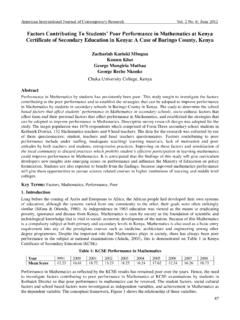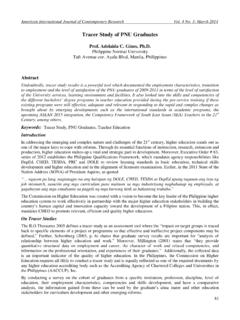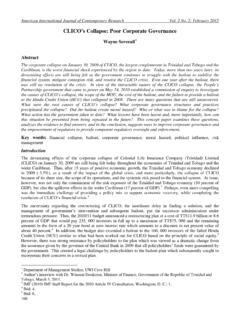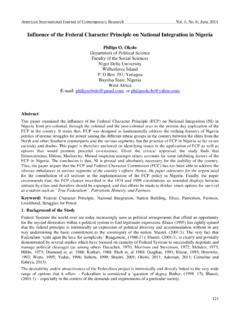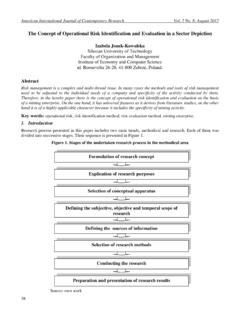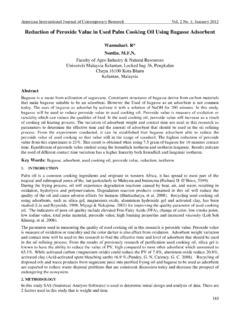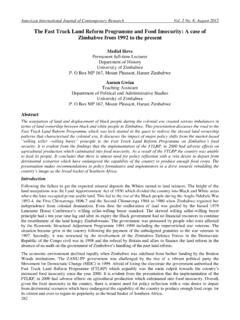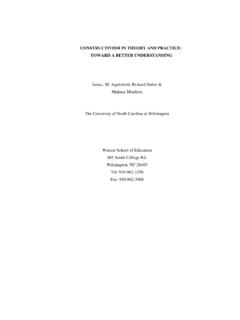Transcription of Applicability of Constructivist Theory in Qualitative ...
1 American International Journal of Contemporary Research Vol. 4, No. 7; July 2014. Applicability of Constructivist Theory in Qualitative Educational Research Tebogo Mogashoa University of South Africa College of Education Department of Curriculum and Instructional Studies PO Box 392. 0003 Unisa South Africa Abstract This article explores constructivism as a Theory in Qualitative educational research. The framework of Applicability of constructivism as a Theory includes the guiding principles of applying it as well as the various types of constructivism in Qualitative educational research. It aims at revealing the Applicability of constructivism and classroom practice. The article recognises that constructing meaning is learning, there is no any other kind of learning other than constructing meaning. Knowledge is acquired through involvement with content instead of imitation or repetition.
2 Drawing from literature, this study explored the various types of constructivism such as social, psychological, personal, radical and contextual constructivism . constructivism is used for research, learning and teaching. Educational curricula and teaching methods are ever changing as well as educational policies on teaching and learning. constructivism is a Theory about teaching and learning which involves essential aspects such as culture, context, literacy, language, learners' interests and needs, personal experiences, interpretation of reality, as well as application of knowledge, which the researcher can analyse to determine their impact on teaching and learning policies. Keywords: Construction, knowledge, creativity, conversations, observations, learners 1. Introduction Anyon (2009:3) argues that Theory and educational research bridges the old-age Theory divide by demonstrating how researchers can use theories to determine appropriate empirical research strategies, and extend the analytical, critical and sometimes emancipator power of data gathering and interpretation.
3 Dressman (2008:9) further states that Theory circumscribes methods of thinking about educational problems and inhibits creativity among researchers, policy makers and teachers. According to Suppes (1974:4), there are five kinds of arguments for using Theory in educational research: i) argument by analogy (although the argument that the success of the natural sciences in the use of Theory provides an excellent example for educational research, it does not follow that Theory must be comparably useful as we move from one subject to the other); ii) reorganisation of experience ( a more important way to think about the role of Theory is to attack directly the problem of identifying the need for Theory in a subject matter); iii) recognition of complexity (one of the thrusts of Theory is to show that what appear on the surface to be simple matters of empirical investigation, on a deeper view, prove to be complex); iv).
4 Deweyan problem solving (inquiry is the transformation of an indeterminate situation that presents a problem into one that is determinate and unified by the solution of the initial problem); and v) triviality of bare empiricism (recording of individual facts and with no apparatus of generalisation or Theory ). According to Maxwell (2010:2), no fact, investigation, or conclusion can be Theory free. The issue is whether one is aware of the Theory one is using and whether one is using it critically or uncritically. In order to understand any educational phenomenon, one needs to also look at the larger social, economic and political contexts within which that phenomenon is embedded, and seek out theories that connect there. Theories can be used not just to understand the individuals, situations and structures studied, but also to change them. One needs to avoid simply citing Theory to support one's argument, and to actually incorporate Theory into the logic of one's study and use it to deepen one's research process.
5 51. Center for Promoting Ideas, USA Formal learning and instruction strategies are inseparable. Yet learning theories only describe how learning occurs, but do not describe the specific methods and activities to follow in order to accomplish the intended learning outcomes. For example, learning theories may describe the age at which a learner may learn punctuations, but the instructional theories will provide guidelines on how to execute the teaching of punctuations. 2. Understanding constructivism constructivism is an epistemology ( Theory of knowledge), a learning or meaning-making Theory that offers an explanation of the nature of knowledge and how human beings learn (Abdal-Haqq 1998:1). An increasingly dominant Constructivist view focuses on the cultural embeddedness of learning, employing the methods and framework of cultural anthropology to examine how learning and cognition are distributed in the environment rather than stored in the head of an individual (Duffy 2006:11).
6 constructivism is a Theory of knowledge (epistemology) that argues that humans generate knowledge and meaning from an interaction between their experiences and their ideas. As a Theory of learning, constructivism is relevant in this study as the researcher wished to establish how learners learn and teachers teach. Hein (2007:1) mentions that constructivism refers to the idea that learners construct knowledge for themselves, each learner individually and socially constructs meaning- as he or she learns. It maintains that individuals create or construct their own new understandings or knowledge through the interaction of what they already know and believe and the ideas, events, and activities with which they come in contact. Constructing meaning is learning, there is no any other kind of learning other than constructing meaning. Knowledge is acquired through involvement with content instead of imitation or repetition.
7 Teachers must provide the learners with the opportunities to interact with sensory data and construct their own world. constructivism is thus a Theory of learning that likens the acquisition of knowledge to a process of building or constructing. Each learner should actively participate in the learning processes as everyone constructs his or her own knowledge. Learning activities in Constructivist settings are characterised by active engagement, inquiry, problem solving, and collaboration with others (Abdal-Haqq 1998:1). Learning is an active process of constructing rather than acquiring knowledge, and instruction is a process of supporting that construction rather than communicating knowledge (Duffy 2006:2). Learning therefore, is simply the process of adjusting our mental models to accommodate new experiences (Wilson 1996:3). Hein (2007:1) argues that learning is not understanding the true' nature of things, nor is it remembering dimly perceived perfect ideas, but rather a personal and social construction of meaning out of the bewildering array of sensations which have no order or structure besides the explanations which we fabricate for them.
8 Rather than the dispenser of knowledge, the teacher is a guide, facilitator, and co-explorer who encourages learners to question, challenge, and formulate their own ideas, opinions and conclusions. Constructivists maintain that when information is required through transmission models, it is not always well integrated with prior knowledge and is often accessed and articulated only for formal academic occasions such as examinations. Learning is an active, constructive process. The learner is an information constructor. New information is linked to prior knowledge. In constructivism learning is an active, contextualised process of constructing knowledge rather than acquiring it. According to Duffy (2006:3), learning involves activity and a context, including the availability of information in some content domain. Knowledge is not passively received but actively built up by the experiential world, not the discovery of ontological reality (Hein 2007:1).
9 The constructivists view learning as an activity in context. Constructivists typically substitute some notion of viability for certainty, that is, we judge the validity of someone's knowledge, understanding, explanation, or other action, not by reference to the extent to which it matches reality but, rather by testing the extent to which it provides a viable, workable, acceptable action relative to potential alternatives (Duffy 2006:3). Knowledge is in the constructive process rather than a finding. Knowledge is not in the content but in the activity of the person in the content domain. The active struggling by the learner with issues of learning constitutes more learning. The instructional methods used include: inquiry, experimentations, observation, interviewing, literature search, summarising and defence of opinion. The learners are involved in the construction of their own understanding, and the social interaction in the classroom is essential to the constructive process.
10 constructivism is a Theory of learning based on the idea that knowledge is constructed by the knower based on mental activity. Knowledge is constructed based on personal experiences and hypotheses of the environment. Learners are considered to be active organisms seeking meaning. 52. American International Journal of Contemporary Research Vol. 4, No. 7; July 2014. The learner is not a blank slate (tabula rasa) but brings past experiences and cultural factors to a situation. According to Martin (1994:45), the philosophy of constructivism proceeds from the premise that: Knowledge does not exist outside the bodies of cognising beings (that is, outside the mind of a learner);. Knowledge is the construction of reality;. Individuals actively construct knowledge by connecting prior and newer learning while working to solve problems. Learning is an active process of constructing rather than acquiring knowledge, and construction is a process of supporting that construction rather than communicating knowledge (Duffy 2006:17).
